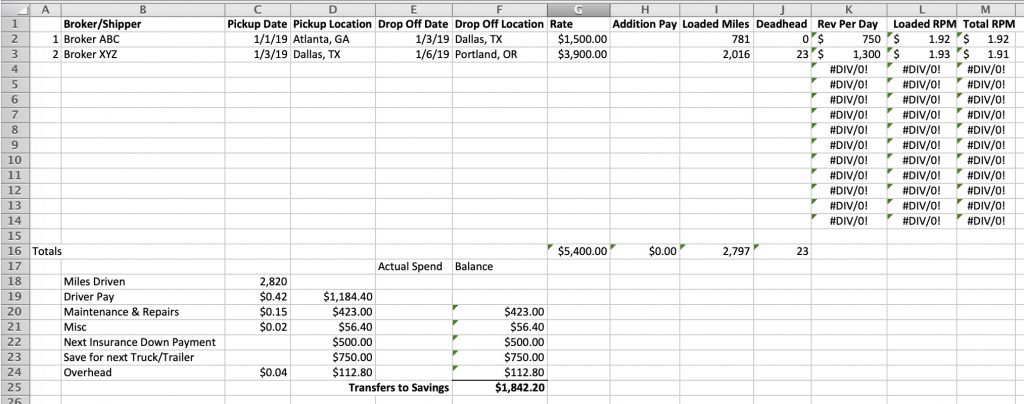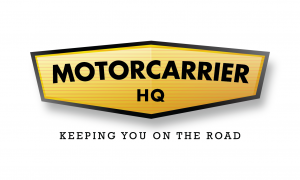August 26, 2019
How to Win As an Owner Operator

I can’t stress this enough. SAVE, SAVE, SAVE, and save more. In my opinion you can’t save too aggressively during your first year of being an owner operator, and saving is a habit you should develop until the day you sell your business.
This is the single biggest habit that is the difference between trucking companies that are able to keep going in almost any circumstances and those who go out of business the first time they run into a little bump in the road.
I believe there are six main areas you need to save for, and I have created a spreadsheet to help you determine how much you need to save in each of those categories. These categories are:
- Maintenance and repairs
- Miscellaneous savings
- Next insurance down payment
- Next truck or trailer down payment
- Overhead
- Taxes
There is a screenshot below that shows what the spreadsheet looks like so you can envision it while you read along. In reality, you can also just use simple math if you prefer, but the spreadsheet just does the work for you.
Download the Spreadsheet for Free
All you need to know is the total number of miles you drove for the month and the savings rate you want to use. I explain the savings rate I used for each category below. In a future episode of the Haulin Assets podcast, I will go into more detail about how I transfer the money around using my accounting system and actual bank accounts. I’ll also make another page to show you how to actually do it.
General Instructions For Using the Spreadsheet
If you have never used an Excel spreadsheet you may want to take an Excel for beginners class. You only need to know the basics to use this spreadsheet, but you do have to have some knowledge.
The spreadsheet has three tabs: sample month, template, and reefer analysis. The sample month is just to give you a general idea of what a month would look like. (I have only listed two loads, but you would probably have closer to 10 by the time you have run a full month.)
You can just delete that tab or use it as a reference. You should never touch the template tab other than to use it to create a new tab for each month. All you have to do is right click on the template tab and create a copy. Once the copy is created, rename the tab the month it is for.
At this point, all you have to do is start entering data into the rows, which is pretty self-explanatory. Then the spreadsheet will calculate the total number of miles you drove for the month and that is what is used to calculate the savings amount for each savings category. The entire savings calculation section is near the bottom of the spreadsheet towards the left.
Maintenance and Repairs
I have read lots of literature over the years about how much fleets spend on repairs and maintenance. I used that info to determine I should save 15 cents ($0.15) a mile for maintenance and repairs. If I drive 10,000 miles in a month, I would put away $1,500 toward maintenance and repairs. “What if you have a repair during the month?” you ask. Great question. I deduct that amount from the amount I would have saved.
For example, if I had a $600 repair I would deduct that from the $1,500 I should be saving and only put $900 into the maintenance and repairs category. The spreadsheet does this for you. If you put the total amount you spent for the month in maintenance and repairs in the “actual spend” category (column E, row 20) it will deduct that from the total amount you need to save and the remaining amount will be in the balance category (column F, row 20).
That is how much you would put into the maintenance and repairs savings category for the month.
“What if I spent more in repairs than I was supposed to save?” you ask. Another great question. If it was just a little more, for example, you spent $1,750 in repairs and were supposed to save $1,500, I would try to make the payment and just not add to the maintenance and repairs savings account for the month.
If it was a lot more, say I had a $2,500 repair, I would transfer money from the maintenance and repairs savings account for the difference. So in this example, I would move $1,000 back into my checking account to cover the entire repair. I would not transfer any money into the maintenance and repairs savings category for that month.
It sure feels good when you have a repair, saved, and have the money set aside for it. That’s a big win.
Miscellaneous Savings
You are going to have expenses you don’t anticipate, or an anticipated expense is going to be more than you expect. This category is to cover those types of expenses. I am saving for those expenses at a rate of 2 cents ($0.02) a mile. The spreadsheet works the same way as described above.
Next Insurance Down Payment
It happens every year and you have to be ready for it. You are going to have to come up with another down payment for your insurance at your one-year anniversary and every year after that. Happy anniversary! I am actually saving a little on the aggressive side, $500 a month. That will give me about $6,000, more than I will probably need, but some day I would like to be able to pay the full year upfront. You save about 10-20% on your premium if you can do that.
Next Truck or Trailer Down Payment
You are eventually going to have to replace your existing truck and trailer, so start saving for it now. If you want to add trucks, you can use this savings category for that too. I have decided to put $750 into this account each month.
Overhead
Every business has some kind of overhead. It’s the type of expense that you basically have to pay just for being in business. Typical overhead expenses are rent, paying an accountant, etc. I am also going to pay for annual expenses like my IRP (truck license plates) out of this account. I decided to save about 4 cents ($0.04) a mile for this category.
Taxes
No one likes this one. The good news is that if you are paying taxes it is because you are making money. Many a successful business owner has gotten into trouble because they did not set aside enough money to pay the tax man. I recommend you set aside 20% of your business profits for taxes. You don’t necessarily need to do this starting the first month, but you will need to do it as soon as you are showing a profit for the year.
If you look at my balance sheet for the first three full months I ran, which is part of Episode 18’s show notes, you will see that my net income for the year is still negative. That is because all the startup costs have not been recouped yet.
Once that number is positive, that is when you for sure should start saving for your tax payment. After three months I am getting close to turning a profit for the year and will probably start saving in either September or October. Stay tuned.
Sample Month
Check out what I saved based on my spreadsheet. You can get the full details by downloading the whole sheet.





